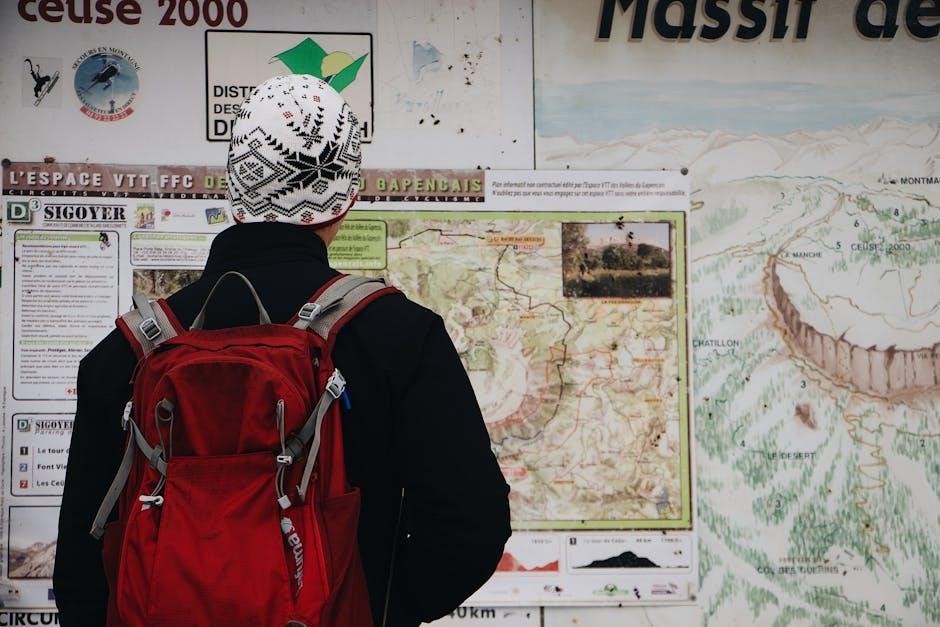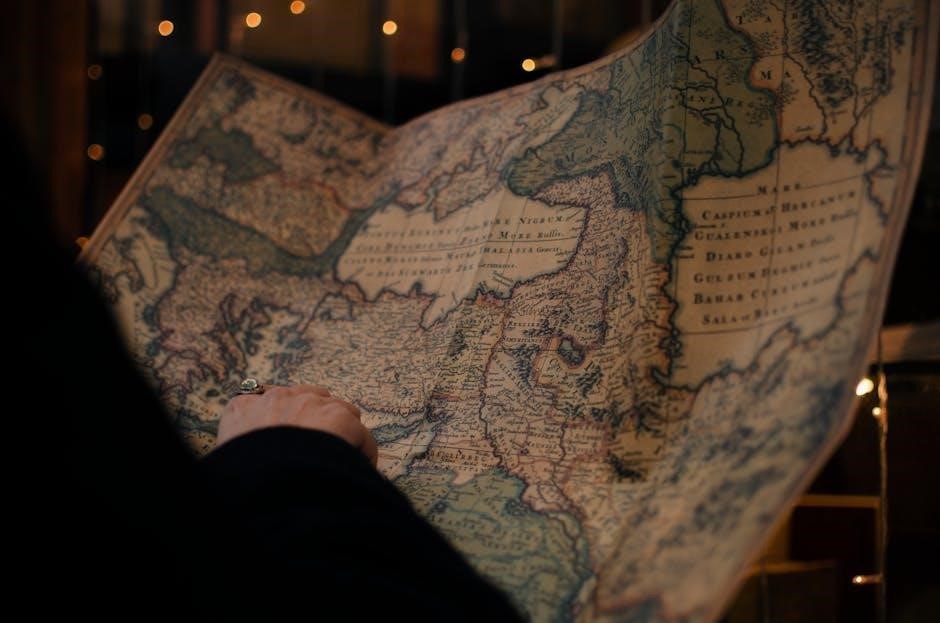The Trail Guide to World Geography is a flexible, family-friendly curriculum designed for grades 3-12, offering a multi-level approach to learning geography through mapping, notebooking, and hands-on activities․
What is the Trail Guide to World Geography?
The Trail Guide to World Geography is a family-friendly, multi-level curriculum designed for students in grades 3-12․ It offers a flexible and engaging approach to learning geography through mapping activities, notebooking, and hands-on exercises․ The curriculum is structured to accommodate multiple grade levels simultaneously, making it ideal for homeschooling families․ With its trail markers, or animal track icons, it guides students through a 36-week program that can be used for more than one academic year․ The guide emphasizes the use of outline maps and atlases, while also encouraging creativity and personalized learning through notebooking․ This comprehensive resource seamlessly integrates geography with other subjects, providing a well-rounded educational experience tailored to individual learning needs and styles․

Key Features of the Trail Guide to World Geography
The Trail Guide to World Geography is a 36-week program designed for students in grades 3-12, offering a multi-level learning approach․ It features trail markers (animal track icons) that cater to three different grade levels, allowing customization for various student abilities․ The curriculum integrates mapping activities, atlas usage, and notebooking to provide a hands-on and creative learning experience․ It is family-friendly, supporting homeschooling for multiple grades and encouraging a flexible, adaptable teaching style․ The guide includes detailed lesson plans, daily geography drills, and opportunities for combining geography with other subjects․ Its open-and-go design makes it easy to use, while optional supplements like Uncle Josh’s Outline Map CD-ROM enhance learning․ This comprehensive resource is ideal for families seeking a fun, interactive, and well-rounded geography curriculum․
Benefits of Using the Trail Guide to World Geography
Using the Trail Guide to World Geography offers numerous benefits for both students and educators․ Its multi-level design allows families to teach multiple grades simultaneously, making it a cost-effective and efficient choice for homeschooling․ The curriculum emphasizes hands-on learning through mapping, atlas work, and notebooking, fostering creativity and retention․ By integrating geography with other subjects like history and science, it provides a holistic understanding of the world․ The program’s flexibility allows customization to suit different learning styles and pacing needs․ Additionally, it encourages critical thinking and real-world applications, preparing students for practical uses of geography in everyday life․ The Trail Guide’s engaging approach makes learning geography enjoyable, ensuring students develop a lifelong appreciation for global studies․ Its adaptability also supports long-term use, with content that can be revisited over multiple years․

Curriculum Structure
The Trail Guide to World Geography offers a comprehensive 36-week program, blending global and regional studies, with adaptable lessons for multi-level learning and flexible pacing․
Overview of the 36-Week Program
The Trail Guide to World Geography spans 36 weeks, divided into structured lessons that explore global and regional geography․ The first 27 weeks introduce foundational concepts, while the remaining weeks delve into specific regions․ Each week includes mapping activities, notebooking exercises, and engaging drills, ensuring a hands-on approach to learning․ The curriculum is designed to be flexible, allowing families to adapt the pace to suit their needs․ With its multi-level structure, the program accommodates students from grades 3 to 12, making it ideal for homeschooling multiple ages simultaneously․ The comprehensive yet adaptable nature of the program ensures a thorough understanding of world geography, fostering curiosity and a love for learning․
Breaking Down the First 27 Weeks
The first 27 weeks of the Trail Guide to World Geography introduce students to foundational concepts, starting with the world as a whole before narrowing to continents, regions, countries, and physical features․ These weeks emphasize mapping skills, notebooking, and daily geography drills, ensuring a comprehensive understanding of global geography․ The curriculum is structured to gradually build knowledge, beginning with broad overviews and progressively focusing on specific areas․ Hands-on activities and adaptable lessons cater to various learning styles, making it suitable for students across multiple grades․ This initial phase lays the groundwork for deeper exploration in the remaining weeks, providing a solid foundation for future learning․
Multi-Level Learning Approach
The Trail Guide to World Geography employs a multi-level learning approach, offering activities tailored to three distinct grade levels: 2-4th, 5-7th, and 8th-high school․ This flexibility allows families to use the curriculum across multiple grades, adapting to each student’s ability and pace․ The use of trail markers, represented by animal track icons, directs students to appropriate tasks, ensuring engagement and challenge․ This approach fosters a collaborative learning environment, enabling siblings to explore geography together while individually progressing at their own levels․ The curriculum’s design supports varied learning styles, making it accessible and effective for diverse educational needs․ By integrating different activities, the Trail Guide ensures a comprehensive and enjoyable learning experience for all participants․
Customizing the Curriculum for Different Grades
The Trail Guide to World Geography is designed to accommodate students across various grade levels, allowing for customization to meet individual needs․ The curriculum is structured to support grades 3-12, with activities tailored to three distinct trails: 2-4th grade, 5-7th grade, and 8th-high school․ This multi-level design ensures that students can progress at their own pace while engaging with age-appropriate content․ Families can easily adapt the curriculum to suit different learning styles and abilities, making it ideal for teaching multiple grades simultaneously․ The flexibility of the Trail Guide allows parents to modify activities, ensuring a personalized learning experience․ This adaptability makes the curriculum a valuable resource for homeschooling families seeking a geography program that grows with their children over multiple years․

Mapping Activities
The Trail Guide emphasizes mapping as a core component, using outline maps and atlases to engage students in interactive geography lessons tailored for different grade levels and abilities․
How to Use Outline Maps Effectively
Outline maps are a cornerstone of the Trail Guide to World Geography, providing a visual and interactive way for students to engage with global and regional geography․ To use them effectively, start by introducing the basics of map reading, such as understanding keys, legends, and scales․ Assign students to label countries, capitals, rivers, and mountains based on the curriculum’s weekly lessons․ Encourage them to color-code regions or themes to enhance visual learning․ Regular practice with outline maps helps reinforce place-name recognition and spatial awareness․ For younger students, focus on tracing and basic identification, while older students can create more detailed maps, including political, physical, or cultural features․ Over time, these exercises build a strong foundation for understanding global relationships and cultural contexts․
Integrating Atlas Usage into Lessons
Atlases are a vital resource in the Trail Guide to World Geography, offering detailed maps that enhance students’ understanding of global and regional landscapes․ Teachers can integrate atlas usage by assigning students to compare outline maps with atlas pages, identifying geographical features like rivers, mountains, and political boundaries․ For younger learners, start with basic label exercises, while older students can analyze cultural, economic, or environmental patterns․ Atlases also support notebooking activities, allowing students to create visual connections between regions and their characteristics․ Regular atlas use fosters spatial awareness and helps students link abstract concepts to real-world contexts, making geography more tangible and engaging․ This integration ensures a comprehensive learning experience that bridges map skills with cultural and environmental understanding․
Notebooking: A Creative Way to Track Progress
Notebooking is a cornerstone of the Trail Guide to World Geography, offering a personalized and creative method for students to document their learning journey․ Through writing, drawing, and mapwork, students can express their understanding of geography in a way that suits their individual style․ Notebooking encourages critical thinking and reflection, allowing learners to connect concepts visually and narratively․ It also provides a tangible record of progress, serving as a portfolio of their geographic discoveries․ This approach is flexible, accommodating students of varying ages and learning styles, and can be tailored to focus on specific regions or themes․ By integrating notebooking with mapping and atlas activities, students develop a deeper engagement with the material, fostering a lifelong appreciation for geography and its real-world applications․

Homeschooling with the Trail Guide
The Trail Guide to World Geography is specifically designed for homeschooling, offering a flexible and multi-level approach that supports teaching multiple grades simultaneously with ease․
Homeschool-Friendly Features
The Trail Guide to World Geography is designed with homeschooling families in mind, offering a flexible and adaptable curriculum that accommodates multiple grade levels․ Its open-and-go format requires minimal preparation, making it easy for parents to implement․ The curriculum includes detailed lesson plans, mapping activities, and notebooking exercises, providing a hands-on learning experience․ With three distinct trails catering to grades 2-4, 5-7, and 8-12, it allows families to customize the program according to their children’s needs․ The ability to reuse the guide for multiple years adds value, while its integration of geography with other subjects like history and science enhances interdisciplinary learning․ Additionally, the curriculum supports teaching multiple grades simultaneously, making it ideal for families with several children․ These features ensure a comprehensive and engaging geography education tailored to the unique demands of homeschooling․
Support for Teaching Multiple Grades

The Trail Guide to World Geography seamlessly supports teaching multiple grades, offering trail markers tailored to three distinct grade levels․ These markers guide parents in assigning age-appropriate activities, ensuring each child engages with material suitable for their learning stage․ For grades 2-4, activities focus on foundational geography skills, while grades 5-7 build on this knowledge with more detailed concepts․ High school students explore advanced topics, preparing them for deeper academic pursuits․ This tiered approach allows families to use the curriculum for multiple years, adapting it to meet the evolving needs of their children․ By integrating diverse learning levels, the Trail Guide fosters a collaborative learning environment where siblings can explore geography together, enhancing both individual growth and family bonding through shared educational experiences․
Combining Geography with Other Subjects
The Trail Guide to World Geography encourages an interdisciplinary approach, seamlessly integrating geography with other subjects like history, science, and language arts․ By incorporating notebooking, students can practice writing and creative expression while documenting their geographical discoveries․ Mapping activities enhance math skills through scale and coordinate practice, while cultural studies align with history lessons․ Field trips and real-world applications connect geography to environmental science, fostering a deeper understanding of ecosystems and conservation․ This holistic approach allows families to weave geography into their broader curriculum, making learning cohesive and engaging․ The Trail Guide’s flexibility supports educators in creating a well-rounded educational experience, where geography serves as a foundation for exploring multiple disciplines in a meaningful and interconnected way․

Additional Resources
The Trail Guide requires outline maps and an atlas, with Uncle Josh’s Outline Map CD-ROM recommended for digital convenience․ Optional supplements like notebooking pages enhance learning․
Required Resources for the Curriculum
The Trail Guide to World Geography requires several essential resources to effectively implement the curriculum․ Outline maps are a cornerstone, used for mapping activities throughout the program․ An atlas is also necessary for reference and to enhance students’ understanding of global geography․ Additionally, the curriculum was originally designed to work with Uncle Josh’s Outline Map Book, though the CD-ROM version is a popular digital alternative․ While notebooking is optional, it is highly recommended as a creative way to track progress and reinforce learning․ These resources are integral to the curriculum’s structure and ensure students engage fully with the material․ They provide the foundation for the hands-on, interactive approach that defines the Trail Guide to World Geography experience․
Optional Supplements for Enhanced Learning
While the Trail Guide to World Geography is a comprehensive curriculum, several optional supplements can enhance the learning experience․ Uncle Josh’s Outline Map CD-ROM is a popular digital alternative to traditional outline maps, offering convenience and flexibility․ Additional geography books or online resources can provide deeper insights into specific regions or cultures․ Educational videos and documentaries about global geography can also supplement lessons, making learning more engaging․ Interactive tools, such as geography-based games or apps, can reinforce concepts in a fun way․ These supplements allow families to tailor the curriculum to their preferences, catering to different learning styles and interests․ They provide opportunities to explore geography beyond the core material, making the learning journey more enriching and dynamic․ These optional resources are designed to complement the curriculum, not replace it, offering flexibility for those who wish to expand their studies․
Tips for Using Uncle Josh’s Outline Map CD-ROM
Using Uncle Josh’s Outline Map CD-ROM with the Trail Guide to World Geography can enhance mapping activities․ First, ensure the CD-ROM is properly installed on your computer․ Familiarize yourself with its features, such as zooming, printing, and saving maps․ Print only the necessary maps to save ink and paper․ Use the search function to quickly locate specific countries or regions․ Experiment with different map styles and labels to customize learning․ Regularly save edited maps to avoid losing progress․ For users encountering page number mismatches, cross-reference the CD-ROM with the Trail Guide to align activities․ Consider using the CD-ROM alongside an atlas for additional context․ Finally, explore all tools and features to maximize its effectiveness in geography lessons․ This resource is a valuable supplement, offering flexibility and convenience for mapping exercises․

Flexibility and Adaptability
The Trail Guide to World Geography offers flexibility by adapting to various grades, adjusting the curriculum pace, and allowing modifications to fit different learning styles and family needs․
Adapting the Curriculum to Your Family’s Needs
The Trail Guide to World Geography is designed to be highly adaptable, allowing families to tailor the curriculum to suit their unique needs and preferences․ With its multi-level approach, it can be used across various grade levels simultaneously, making it ideal for homeschooling families with multiple children․ The curriculum offers flexibility in pacing, enabling parents to adjust the speed of lessons based on their children’s learning abilities․ Additionally, the inclusion of optional supplements and the ability to integrate field trips provide further customization options․ This adaptability ensures that the curriculum remains engaging and effective for different learning styles and family dynamics, fostering a personalized educational experience․
Using the Trail Guide for More Than One Year
The Trail Guide to World Geography is designed to be used for more than one academic year, offering a flexible and reusable curriculum for families․ Its multi-level structure allows parents to revisit the material with the same child as they progress in grade levels, with each year building on the previous one․ Additionally, the curriculum can be used with multiple children across different grades, making it a cost-effective and efficient resource for homeschooling families․ The guide’s adaptability ensures that the learning experience remains fresh and engaging, with new insights and challenges each year․ This long-term usability makes the Trail Guide a valuable investment for families committed to a comprehensive geography education․
Incorporating Field Trips and Real-World Applications
The Trail Guide to World Geography encourages families to venture beyond the classroom by incorporating field trips and real-world applications into their learning․ These hands-on experiences help students connect classroom lessons to actual geographical features, cultures, and environments․ Parents can plan visits to local landmarks, national parks, or museums to reinforce concepts learned through mapping and notebooking․ Additionally, the curriculum suggests activities like observing ecosystems, exploring urban layouts, or participating in cultural events to deepen understanding․ By integrating field trips and practical applications, the Trail Guide fosters a more engaging and memorable learning experience, allowing students to see geography in action and develop a greater appreciation for the world around them․

Real-World Applications of the Trail Guide
The Trail Guide connects geography to everyday life, helping students explore cultures, environments, and global issues through practical experiences and real-world applications․
Understanding Global Cultures Through Geography
The Trail Guide to World Geography helps students explore global cultures by integrating mapping, notebooking, and atlas usage․ Through hands-on activities, learners visualize and document cultural diversity, fostering a deeper appreciation for global interdependence․ The curriculum’s multi-level design allows families to study together, making cultural exploration a shared experience․ By connecting geography to real-world cultures, the guide prepares students to engage thoughtfully with our increasingly interconnected world․
Exploring Environmental Interactions
The Trail Guide to World Geography emphasizes understanding how environments shape cultures and ecosystems․ Through mapping activities and atlas usage, students analyze climate zones, natural resources, and human impact on landscapes․ Notebooking encourages reflection on environmental interactions, fostering stewardship and global awareness․ The curriculum integrates real-world applications, helping learners connect geography to ecological and cultural systems․ By exploring these connections, students gain insights into the intricate relationships between people and their environments, preparing them to address environmental challenges thoughtfully․ This hands-on approach makes environmental learning engaging and meaningful, aligning with the Trail Guide’s mission to inspire curiosity and responsibility for the world we inhabit․
Geography in Everyday Life
The Trail Guide to World Geography highlights how geography influences daily life, from navigation to understanding global cultures․ By exploring maps and engaging in notebooking, students see how geographic knowledge applies to real-world scenarios, such as planning trips or understanding climate impacts․ The curriculum emphasizes practical skills like reading atlases and using outline maps, which are essential for everyday decision-making․ Through hands-on activities, learners develop a deeper appreciation for how geography shapes their interactions with the world․ This approach makes learning relevant and accessible, encouraging students to see geography as a vital tool for navigating and understanding their surroundings․ The Trail Guide’s focus on everyday applications ensures that geography becomes a lifelong skill, not just a classroom subject․

Reviews and Testimonials
Families and homeschoolers praise the Trail Guide to World Geography for its flexibility, ease of use, and effectiveness in teaching geography across multiple grades with engaging activities․
What Users Are Saying About the Trail Guide
Families and educators consistently praise the Trail Guide to World Geography for its flexibility and effectiveness․ Many highlight its ability to engage students of various ages and skill levels, making it ideal for multi-grade teaching․ Users appreciate the combination of mapping, notebooking, and hands-on activities, which foster a deeper understanding of geography․ The curriculum’s adaptability is frequently commended, as it allows parents to tailor lessons to their children’s needs․ Some users mention using it alongside other resources, such as Uncle Josh’s Outline Map CD-ROM, to enhance learning․ Overall, the Trail Guide is celebrated for its user-friendly design and its ability to make geography fun and accessible for the whole family․
Success Stories from Families Using the Curriculum
Families using the Trail Guide to World Geography often share inspiring success stories․ Many report that the curriculum has sparked a lifelong love of geography in their children․ One family mentioned that their three children, spanning multiple grades, were able to learn together seamlessly due to the multi-level design․ Another parent highlighted how the hands-on activities, such as mapping and notebooking, helped their child retain information better than traditional textbooks․ Several users noted that the curriculum’s flexibility allowed them to adapt lessons to their family’s unique needs, making homeschooling more enjoyable and effective․ Overall, families praise the Trail Guide for its ability to make geography engaging and accessible, while also fostering a deeper understanding of the world․
Empowering learners with a flexible and engaging approach, the Trail Guide to World Geography fosters a lifelong appreciation of global cultures and environments, inspiring future explorations and discoveries․
Final Thoughts on the Trail Guide to World Geography
The Trail Guide to World Geography stands out as a comprehensive and flexible curriculum, offering a engaging approach to learning about our global world․ Its multi-level design ensures that students of various ages and abilities can thrive together, making it an excellent choice for families or classrooms with diverse needs․ The integration of mapping activities, notebooking, and real-world applications fosters a deep understanding of geography while promoting critical thinking and creativity․ Many users have praised its adaptability, allowing it to be tailored to different learning styles and educational goals․ The curriculum’s emphasis on hands-on learning and exploration makes it a valuable tool for developing a lifelong appreciation of global cultures and environments․ Overall, the Trail Guide to World Geography is a well-crafted resource that effectively balances structure with flexibility, providing a meaningful and enjoyable educational experience․
Expanding Your Geography Journey Beyond the Trail Guide
The Trail Guide to World Geography serves as a robust foundation for exploring the world, but the learning journey doesn’t have to end there․ Families and educators can expand their geography studies by incorporating additional resources, such as documentaries, global literature, and cultural exchanges․ Field trips to museums, national parks, and international festivals can deepen understanding and make learning immersive․ Encouraging students to participate in geography clubs or competitions can further ignite their passion for global awareness․ Additionally, integrating technology, such as geographic information systems (GIS) or interactive mapping tools, can provide advanced skills and real-world applications․ By connecting geography to current events, environmental studies, and cultural traditions, learners can develop a lifelong appreciation for the interconnectedness of our world․


